Page 328 - IJB-10-5
P. 328
International
Journal of Bioprinting
RESEARCH ARTICLE
3D-Printed mesoporous bioglass/
polycaprolactone scaffolds induce macrophage
polarization toward M2 phenotype and
immunomodulates osteogenic differentiation of
BMSCs
Weihua Huang 1,2,3,4† id , Shuai Huang 1† id , Xitao Linghu 3 id , Wei-Chih Chen 1 id ,
* ,
Yang Wang 1 id , Jingjie Li 1 id , Huinan Yin , Hang Zhang 1 id , Weikang Xu 2,5,6 id
1
and Qingde Wa *
3 id
1 Department of Orthopaedic Surgery, the Second Affiliated Hospital of Guangzhou Medical
University, Haizhu District, Guangzhou, Guangdong, China
2 Institute of Biological and Medical Engineering, Guangdong Academy of Sciences, Jianghai
Avenue Central, Haizhu District, Guangzhou ,Guangdong, China
3
Department of Orthopaedic Surgery, the Second Affiliated Hospital of Zunyi Medical University,
Zunyi, Guizhou, China
4 Department of Orthopaedic Surgery, The Affiliated Qingyuan Hospital (Qingyuan People’s
Hospital), Guangzhou Medical University, Qingcheng District, Qingyuan, Guangdong, China
5 National Engineering Research Center for Healthcare Devices, Guangdong Provincial Key
Laboratory of Medical Electronic Instruments and Materials, Guangdong Institute of Medical
† These authors contributed equally Instruments, Tianhe District, Guangzhou, Guangdong, China
to this work. 6 Guangdong Chinese Medicine Intelligent Diagnosis and Treatment Engineering Technology
Research center, Jianghai Avenue Central, Haizhu District, Guangzhou ,Guangdong, China
*Corresponding authors:
Weikang Xu
(759200816@qq.com)
Qingde Wa
(wqd887zsy@126.com) Abstract
Citation: Huang W, Huang S,
Linghu X, et al. 3D-Printed Bioceramic composite polycaprolactone (PCL) scaffolds are widely used in bone
mesoporous bioglass/ defect repair studies. Among them, bioactive glass (BG) is considered an excellent
polycaprolactone scaffolds induce
macrophage polarization toward M2 bone-based repair material due to its unique inorganic amorphous structure,
phenotype and immunomodulates bioactivity, and osseointegration properties. However, the dense pores and low
osteogenic differentiation of BMSCs. specific surface area of ordinary BGs and mesoporous BGs limit the mechanical
Int J Bioprint. 2024;10(5):3551.
doi: 10.36922/ijb.3551 properties and bioactivity of the overall scaffolds, and it is often necessary to increase
the proportion of BGs to offset these shortcomings. Here, we prepared highly active
Received: April 30, 2024 dendritic mesoporous structured bioactive glass (MBG) with a high specific surface
Accepted: June 19, 2024
2
3
Published Online: July 31, 2024 area (457.14 m /g) and pore volume (1.38 cm /g) by sol-gel method. PCL scaffolds
containing different percentages of MBG were prepared by three-dimensional
Copyright: © 2024 Author(s).
This is an Open Access article printing technology, and the physicochemical and immunomodulatory osteogenic
distributed under the terms of the properties were investigated. The results showed that the low-concentration MBG/
Creative Commons Attribution PCL scaffolds with 10% content (10MBG/PCL) possessed the highest compressive
License, permitting distribution,
and reproduction in any medium, strength (about two times that of pure PCL scaffolds) and excellent in vitro
provided the original work is immunomodulatory osteogenic properties. Finally, 10MBG/PCL was selected for
properly cited. further exploration to investigate the effects of different fiber diameters (F300, F500,
Publisher’s Note: AccScience F800) and pore sizes (P200, P500, P800) on the scaffolds performance. Ultimately, we
Publishing remains neutral with found that the 10MBG/PCL scaffolds with fiber diameter and pore size of 500 μm had
regard to jurisdictional claims in
published maps and institutional high osteogenic potential, significantly induced macrophage polarization toward
affiliations. the M2 phenotype, and downregulated the expression of inflammatory genes
Volume 10 Issue 5 (2024) 320 doi: 10.36922/ijb.3551

